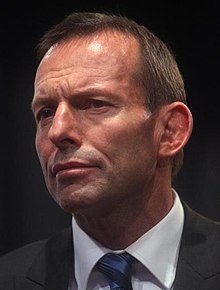Abbott government
|
The Honourable Tony Abbott MP |
|
|---|---|
 |
|
| Prime Minister of Australia | |
|
In office 18 September 2013 – 15 September 2015 |
|
| Monarch | Elizabeth II |
| Governor-General |
Dame Quentin Bryce Sir Peter Cosgrove |
| Deputy | Warren Truss |
| Preceded by | Kevin Rudd |
| Succeeded by | Malcolm Turnbull |
 |
This article is part of a series about Tony Abbott |
|---|---|
|
|
The Abbott Government was the federal executive government of Australia led by Prime Minister Tony Abbott. The Government was made up of members of the Liberal–National Coalition. The Leader of the Nationals, Warren Truss, served as Deputy Prime Minister. Following the 2013 Australian federal election on 7 September, the Coalition defeated the second Rudd Government, ending six years of Labor Government. The Abbott Government was sworn into office on 18 September 2013. Less than two years later on 14 September 2015, Malcolm Turnbull defeated Abbott in a leadership ballot, 54 votes to 44.
In economic policy, the Abbott Government aimed to rein in a budget deficit that reached A$48.5 billion by June 2014. It concluded free trade agreements with China, Japan and South Korea. It removed the Rudd-Gillard era Resource Super Profits Tax and carbon pricing. It established the National Commission of Audit to advise on restoring the Budget to surplus; instituted the Royal Commission into trade union governance and corruption; founded the Medical Research Future Fund; and produced White Papers on Developing Northern Australia and the Agricultural Competitiveness. Treasurer Joe Hockey delivered two Budgets, the first focused on expenditure reduction measures, but faced a hostile reception in the Senate and media. Partial deregulation of universities, and a $7 contribution to doctor visits were proposed, but blocked by the Senate. The second Budget emphasised stimulus for the small business sector.
...
Wikipedia
